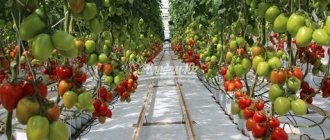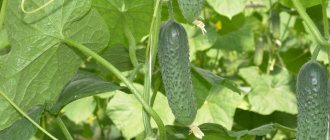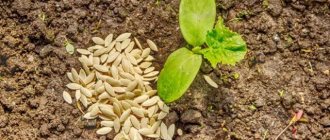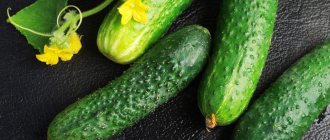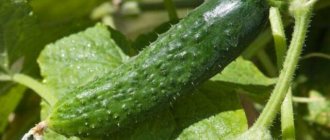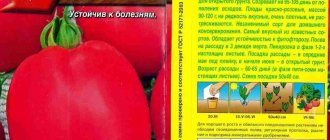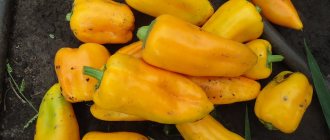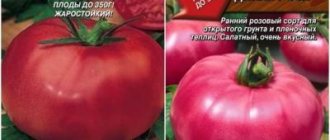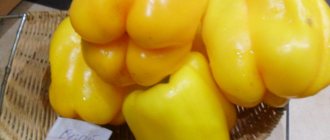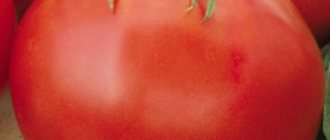Dirigent F1 is a unique hybrid, bred from crossing 3 hardy, productive varieties. It has become the embodiment of the best properties of cucumbers. Among the indisputable bonuses are super productivity, cold resistance, and tolerance of sudden temperature changes.
| Landing location | Ripening time | Mode of application | Fruit length | Group | Fruit smoothness | Pollination method |
| Universal | Early ripening (35-45 days) | Universal | Medium - from 10 to 15 cm | Hybrid | Highly lumpy | Parthenocarpic |
Characteristics of the variety
This is a first generation hybrid, obtained by breeders (Germany) in 2006.
The variety was included in the State Register of Breeding Achievements of the Russian Federation in 2011 and zoned. Recommended for open ground, but in the northern regions it must be grown in protected ground. It has a medium-early harvest time (40–42 days from germination). Did you know? The name “cucumber” is derived from the Greek word for “unripe”, and this is logical, because cucumbers are actually eaten unripe.
This indeterminate type produces a medium-sized plant with medium branching. It is not very densely covered with medium-fine green foliage. The leaf blade is slightly wrinkled and attached to the stems with a long petiole. The shoots regenerate well. A node may contain 1–3 female flowers.
The fruits grow to a maximum of 14 cm, but usually have a length of 10 cm with a length-to-diameter ratio of 3.1 to 1. The average weight of greens is 67–80 g. They have a cylindrical shape, thin green skin with short light stripes at the ends and slight spotting .
There are many small tubercles on the surface. Inside, the pulp has a white-green color, good density and juiciness, small milky seeds. It has an excellent taste - sweetish, without bitterness.
Productivity
High yields can be harvested from cucumbers of the Dirigent variety - 476–692 kg per 1 ha. In the beds, the yield with proper care reaches 10 kg per 1 m². This hybrid is characterized by uniform fruit production.
Like many hybrids, the variety has good immunity and tolerates unfavorable conditions in the area where it is zoned. It is resistant to olive blight and cucumber mosaic virus.
Did you know? Regular consumption of fresh cucumbers improves metabolism and the body gets rid of “bad” cholesterol.
- This variety can attract gardeners for the following qualities:
- high and stable productivity;
- no need for pollination;
- disease resistance;
- ability to withstand weather vagaries;
- versatility of fruit use;
- early ripeness;
- transportability;
- great taste;
- commercial appearance of fruits that do not outgrow.
The disadvantages of the variety include the fact that it is a hybrid and seed material has to be constantly purchased.
The harvest of Dirigent cucumbers can be obtained within 36–40 days after planting the seeds. The fruits are collected as they ripen. Cucumbers are consumed fresh.
The fruits are suitable for whole pickling and canning for the winter.
It is advisable to keep fresh cucumbers indoors for no more than two days, after which they begin to wither. On the refrigerator shelf, vegetables are stored in a bag for up to 5–10 days. In the cellar at a temperature of 6 ... 8 ° C in boxes or cardboard boxes, storage can be carried out for a decade.
Cucumbers of the Dirigent variety are parthenocarpic, therefore they do not require pollination, have excellent taste, are resistant to some diseases, are productive and have virtually no disadvantages. Like all early varieties, they can be sown directly into the ground, but the seedling method will allow you to get an earlier harvest.
The plant is identerminate and has medium vigor. The culture exhibits shoot regeneration. The variety has long internodes. The leaf size is small to medium. The color may be green or dark green with a slightly wrinkled surface having a long petiole.
Attention!
One leaf node can contain up to 3 female flowers.
Fruit characteristics:
- The cucumbers of this variety are cylindrical in shape.
- Has an average length of 10 cm (maximum 14).
- The fruit has a thin skin, colored green.
- There are short light stripes or slight spotting.
- On the surface there are small, frequent tubercles with light, dense pubescence.
The pulp is dense and has no voids. The taste is delicate, juicy, without bitterness and has a pale green color. The taste is sweet, for which it is valued by gardeners. The chamber with the seeds is small and has milky ripeness. During the harvesting period, the fruits do not change their size. The usual weight of a cucumber is about 60-80 grams.
Main characteristics of the variety:
- Mid-early, from the moment of seedling formation to fruiting it takes up to 45 days.
- It has uniform and constant fruiting throughout the entire period, the yield is up to 650 c/ha.
- Good immunity. The State Register notes high yield and resistance to blight and mosaic virus.
- The harvest is established both in open and closed ground. This can often happen even under unfavorable conditions.
- The variety adapts well to environmental conditions.
- The fruits retain their shape.
- They have good transportability and increased shelf life.
- The method of using cucumbers is universal. Can be used in salads, canned and pickled.
From one bush, with proper care, you can get from 4 to 7 kg per 1 m2.
Advantages:
- the variety is early ripening;
- high productivity;
- unpretentious;
- shape and size are uniform;
- increased resistance to diseases.
The disadvantages include:
- the seeds have a high price because they are difficult to obtain.
- It is not possible to collect planting material yourself.
The main feature of the variety is that it can bear fruit abundantly even under unfavorable conditions.
Growing cucumber Dirigent
Among the many species, the Dirigent cucumber is one of the most common crops. It was bred in the Netherlands by crossing 3 varieties. From each of them, Dirigent f1 received only the best characteristics, thanks to which it is highly valued by gardeners.
Growing cucumber Dirigent
Characteristics of the variety
Dirigent cucumbers can grow in almost any conditions. It is distinguished from other hybrid crops by an average level of branching. It has a fairly high yield.
This variety of cucumbers is classified as dietary. Often this product becomes part of various diets, not only in its pure form, but also as part of salads and other dishes. Its taste characteristics make it possible to obtain excellent preservation.
The plant has a high level of resistance, which is why many gardeners choose it for planting on their plots. The cost of one bag of seeds averages 75 rubles.
Bushes
According to the description, cucumbers of the Dirigent variety are medium-sized. The side shoots are weak, which is why they die at the beginning of development. The most important shoots always appear only on the main stem.
The leaves on the bushes are small and dark green. They are smooth in structure. The bushes are distinguished by female flowering; there are always no more than 3 female flowers in a node.
Fruit
The average length of one fruit is 11 cm. They are not too large in size, weighing about 90 g. Cucumbers have a delicate and thin skin with small tubercles.
The description of the fruit pulp is as follows: it is always crispy and has a pleasant aroma. Vegetables have high taste qualities. They have no bitterness, so they are a great addition to any salad.
Productivity
The Dirigent variety has a high yield level. From 1 m² you can harvest approximately 4.5-5 kg of fruit. With proper care, the yield can be increased to 7 kg.
Such indicators are possible due to the excellent regeneration of the plant and the absence of the need for pollination. Fruiting begins 40 days after sowing the seeds. The plant grows well in greenhouse conditions, so the harvest can be harvested throughout the year.
Disease resistance
Cucumber Dirigent f1 has good resistance to diseases such as:
- cucumber mosaic;
- powdery mildew;
- brown spot.
Advantages and disadvantages
The variety is resistant to various diseases
The main advantages of the variety are:
- resistance to temperature changes;
- good heat tolerance;
- early maturation;
- excellent yield;
- resistance to the most common diseases.
The only downside to cucumbers is that the plant can be susceptible to airborne diseases.
Planting methods and rules
There are 2 ways of planting cucumbers: seedlings and non-seedlings. Each of them has its own characteristics. The first method is a little more complicated, so it is recommended for more experienced gardeners.
Seedling method
Planting cucumbers using seedlings is done as follows:
- first prepare the container and fill it with a mixture of garden soil, peat and sand;
- the seeds are kept in a 1% solution of potassium permanganate and then placed in a container (planting depth - no more than 2 cm);
- add another layer of earth;
- wrap the container with film and water it with warm water once a day;
- provide optimal conditions for planting - the temperature should be 20-25 °C;
- with the emergence of shoots, the film is removed and the temperature is reduced to 18 °C;
- then, when the seedlings get stronger, they are transplanted into open ground, into holes, the distance between which should be at least 10 cm. 0.5 m is left between the beds.
Seedless method
In this case, the seeds are immediately planted in the ground. The best time for this is the beginning of May. Large seeds are needed for planting.
Planting material is placed to a depth of 3 cm, no more. Place 3 seeds in each hole. The optimal distance between the holes is 6-12 cm. Between the beds - 60 cm.
Dirigent cucumbers love water. Depending on air humidity, they are watered 3-7 times during the week. The area should not be darkened to prevent the cucumbers from drying out.
It is important to monitor the appearance of weeds and remove them immediately. The soil must be loosened
Then there will be enough air for the plant.
For feeding, choose minerals or organic matter. The first feeding is carried out 14 days after emergence. Another 2 are done before flowering begins and after it ends.
Hybrid description details
Cucumber Dirigent F1 is a productive hybrid from the Netherlands. In the Russian Federation, it received registration in the State Register in 2011, although before that it had been used by gardeners for more than 5 years. The annotation for the variety indicates its zoning only in the Center of the country. Planting is recommended only in open beds. Cucumbers are not actually grown in a greenhouse. But they are actively planted in the ground under film cover.
The bush is an indeterminate, powerful plant with a large and branched root. The leaf is medium or small. Provided they are cared for correctly, cucumbers are knitted in groups of 2-5 pieces. The skin of the fruit is thin, has a uniform color without yellow fragments and stripes (see photo).
| By type of growth | long-climbing |
| By type of branching | Medium branched |
| By type of pollination | Parthenocarpic |
| Planting scheme | 30×70 cm |
| Weight, length and shape of the fruit | 65-80, 8-10 cm, cylindrical, dark green, finely tuberculate with white pubescence |
| Ripening period | Early ripening (40-42 days) |
| Usage | Universal |
| Drop off point | OG or greenhouse |
| Diseases | Low susceptibility to field cucumber mosaic virus, powdery mildew and olive spot |
| Flowering type | Predominantly female |
| Productivity | Product indicator - about 10 kg/m2 |
Dense and crispy cucumbers have a good taste. Their pulp is dense, and the seeds are underdeveloped. Therefore, nothing prevents you from appreciating the taste of greens. The harvest is good both fresh and pickled. Small and short cucumbers are also pickled.
Excellent taste without bitter notes is not the only advantage of the hybrid. Other advantages:
- Self-pollinating.
- Early start of fruiting.
- High yield.
- Uniform gradual setting throughout the growing season.
- Friendly maturation. One-dimensionality of fruits in the harvest from one bush.
- Resistance to some species diseases.
- General stress resistance in the garden. Cucumbers tolerate weather vagaries well. In case of damage, they restore strength relatively quickly due to their high ability to regenerate.
Negative characteristics of the variety:
- cucumber tolerance to certain diseases;
- hybrid origin - seeds cannot be collected;
- high cost of planting material.
Cucumber variety Dirigent (F1)
The early period of fruiting and the universal use of the crop among cucumber varieties are highly valued. The German company Rijk Zwaan Welver GmbН, specializing in the sale of seed material, offered vegetable growers a new hybrid - Dirigent, which meets these qualities. An application for registration of the new product was submitted in 2006; the cucumber was included in the State Register of Breeding Achievements of Russia in 2011. After variety testing, the variety was zoned in the Central region, including Bryansk, Vladimir, Kaluga, Ivanovo, Ryazan, Moscow, Smolensk and Tula regions. It is recommended for cultivation in open ground, but in cool regions this crop is also successfully grown in greenhouses. This is a hybrid, so the seeds are always labeled F1.
Pollination and disease resistance
The Dirigent cucumber variety is a parthenocarpic hybrid and therefore does not require pollination.
Note!
When grown vertically, Dirigent cucumbers are more resistant to disease, since this method reduces the contact of the plant's leaves with the soil.
The most commonly used remedies for diseases:
- For powdery mildew, it is necessary to use fungicides or a prepared solution of colloidal sulfur for further treatment.
- Cladosporiosis - the plant must be sprayed with Bordeaux mixture and watering must be reduced for a while.
- If there is a whitefly invasion, you need to use tobacco leaves and carry out regular weeding.
- When ants appear and to combat them, it is necessary to water the soil with boiling water or chlorine-containing preparations.
Regular processing of the plant prevents cucumbers from becoming infected with various diseases.
Care
To achieve excellent yields of Dirigent cucumbers, you need to adhere to a number of growing rules:
- The variety loves light and water, so it is necessary to water the bushes 3-7 times a week. The amount of watering depends on the ambient temperature and climate.
- It is enough to apply complex fertilizers once a month, organic additives - every week.
- Before planting in open ground, harden the plants, reducing the temperature to 15-16˚C.
- After planting in the ground, water the plant generously.
- We must not forget to remove weeds so that they do not interfere with the growth of bushes and the development of fruits, water and loosen the soil so that the soil receives the necessary amount of air.
For gardeners, cucumber f1 is the best choice among all cucumbers.
Features of agricultural technology, tips
Direct sowing of Dirigent F1 cucumber seeds into the soil in early May. Cover the bed with film, even if you grow the crop outdoors. When using the seedling method, plant bushes in a permanent place at the age of 20-25 days. In both cases, place no more than 3-5 plants per 1 square meter in the ground. m.
Advice. The hybrid is cultivated without garter.
Sowing seeds for seedlings | Planting seedlings in a greenhouse | Planting seedlings in exhaust gas | Stepsoning | Harvesting (in the greenhouse / in the greenhouse) |
| All April | First half of May | The beginning of June | Not necessary | Mid June/end of June |
| *dates are indicated for the middle zone | ||||
You may be interested in:
Landing conditions must be observed. The soil should be rich in humus, mineral and organic fertilizers. Avoid growing in heavy or sandy soils. It is necessary to regularly apply organic fertilizers; it is advisable to grow legumes on the land before cucumbers grow. The soil should be rich in humus or manure. Seeds should be planted at a distance of 15 cm from each other.
Seedlings are formed within 2 weeks if favorable conditions are created for it. The best distance for plant growth is considered to be 60 cm. Before planting the seeds you need:
- handle;
- remove questionable seeds with mold and stains.
The remaining seeds must be soaked in a special solution (Maxim) for several hours. After this, the seeds can be planted in the ground. Afterwards it is necessary to cover with covering material until shoots emerge.
In regions with low temperatures, the seedling method should be chosen. Before planting, the seeds are soaked for several hours, the soil must be disinfected. After planting the seeds, cover the box with seedlings with film and place in a warm place. The optimal temperature for germination is 25 °C.
Cucumber Dirigent: description, planting and care, reviews, photos
The Dirigent cucumber is an unpretentious, versatile variety that can be grown in any garden plot. Fruit ripening begins in early spring and continues throughout the season until September. The variety was bred in Holland relatively recently and has earned the attention of gardeners due to its early ripening and high taste qualities of the fruit.
Characteristics of Dirigent cucumbers
It is better to start describing the Dirigent cucumber variety by showing a photo.
This is an early ripening, hybrid variety that does not require pollination. It can be grown in open and closed ground. For good fruiting, regular and abundant watering is important.
The plant has strong, strong shoots that form and constantly regenerate on the main stem. The lateral processes are weak, often die, and do not develop completely.
After sowing, the seeds germinate quickly and amicably. Fruit ripening occurs 40 days after seedlings are planted in the ground.
Important! The vines of Dirigent cucumbers are short, so the plant does not need to be tied up.
The leaves are small, serrated, sparse. Thanks to their small leaf size and small quantity, cucumbers are quite easy to harvest.
The fruits of the Dirigentne variety are large, up to 15 cm in length and up to 80 g in weight. Their size remains virtually unchanged throughout the entire ripening stage. 2-3 cucumbers are formed in one fruit node. The skin of the fruit is dark green, thin, lumpy. There are short yellow stripes on the surface.
Taste qualities of cucumbers
The taste of the fruit is high: the pulp is tender, juicy, crispy with a characteristic cucumber aroma. There is no bitterness inherent in cucumber crops. The seed chamber is small, the seeds are small, soft, and are always in the stage of milky maturity.
Pros and cons of the variety
The negative qualities of the variety include the high cost of seed material; it cannot be collected independently at home.
Among the positive properties are:
- variety resistance to powdery mildew, brown spot, cucumber mosaic virus;
- high productivity;
- rapid fruit ripening;
- drought resistance;
Important! The fruiting of the variety is constant and uniform throughout the entire period of ovary formation.
Cucumbers of the Dirigent variety are grown from seeds or seedlings. To get an early harvest in a greenhouse or open ground, use the seedling method of growing under film. Seedlings are planted in greenhouses in May. Plants are rooted at the rate of 3 seedlings per 1 m2. When planting in open ground, use a scheme of 5 plants per 1 m2.
The optimal soil temperature for rooting in open ground should be + 18 ᵒC. Watering is carried out at least 2-3 times a week.
To obtain high yields, cucumbers are fed with organic or mineral fertilizers up to 5 times per season. Once every 7 days, remove weeds, water the plant at the roots, and mulch the soil. When pests appear, spray with chemicals or use folk remedies.
Growing cucumbers Dirigent F1
The variety is recommended for cultivation in the central and southern regions of Russia. In this area, cucumbers can be planted directly in open ground in May.
In the northern regions of the country, the variety can also be grown, but in a greenhouse or heated greenhouse. Farmers send reviews with photos and descriptions of Dirigent cucumber fruits from almost every region of Russia.
This only confirms the fact that the variety can be grown in any climatic conditions.
Direct planting in open ground
In the south of Russia, seedlings or seeds of Dirigent cucumbers are planted in late April or early May in open ground. At this time there are no longer night frosts.
The area for planting is dug up and organic fertilizers are added: manure, peat, humus. You can also use potassium-phosphorus fertilizer.
For seeds, long, narrow grooves are cut into which the seeds are placed with the sharp end up. They are deepened no more than 10 mm. Then they are covered with soil and watered.
At the last stage of planting, the soil is mulched. This will conserve moisture and slow down weed growth.
Important! If there is a possibility of night frosts, the seedlings are covered with film in the evening and removed in the morning.
Cucumber seedlings can be purchased or grown at home. To do this, the seeds are planted in special containers. They are filled with soil from the garden plot or purchased special planting soil.
Furrows are cut in it and seeds are placed there, then they are covered with a thin layer of earth and watered. The containers are covered with film and placed in a warm, well-lit place. After 3 days, the covering material can be removed.
As soon as 2-3 true leaves appear on the seedlings, the grown plants can be planted in the ground. Dirigent cucumbers take root well and grow in any type of soil.
Seedlings are planted in holes filled one third with humus or peat. The distance between each plant should be at least 30 cm. Before planting, the soil is also carefully dug up and fertilized. After the seedling has rooted, the hole is filled with loosened soil, watered abundantly, and mulched.
Growing and care
The Dirigent variety is recommended to be grown both in open ground and under film cover. Gardeners often cultivate this variety through seedlings, but it can be planted directly into the ground using covering material. Dirigent is a hybrid variety. Seed germination is friendly, no additional seed treatment is required.
Reference!
The most suitable soil for seedlings is taken from the greenhouse in which the plant will subsequently grow. After planting, the plant adapts to this soil composition faster.
Basic sowing rules:
- Seedlings are planted in the ground as soon as the ground warms up to 20 ° C.
- Seedlings must be planted in a greenhouse in early May at the age of 20 days.
- The plant should form up to 3 leaves.
- Before planting seedlings, it is necessary to add humus or peat to the holes, then mulch them. Mulching helps attract earthworms, which loosen the soil, increase oxygen access to plants and supply the soil with oxygen and microelements.
- Seeds must be planted with their nose up, maintaining an angle of 45 ° C, planting depth no more than 1 cm, this will speed up the germination process.
- After planting, the bed should be covered with covering material. Water for irrigation should be warm.
- When the first shoots appear, watering must be reduced. The earth should be moistened in moderation, but there should not be an excess of water. Watering is carried out in the morning and evening.
- At first, the soil must be loosened actively to ensure an active flow of oxygen to the roots. Care must be taken not to damage the root system.
When the seeds hatch, they are planted into separate cups using tweezers (it is better to use peat cups; they can be planted directly into the ground). Seeds should be buried no more than 1 cm.
If you grow seedlings in a greenhouse, it must be heated. During the day, the temperature for the bushes should be increased and the lighting should be increased. At night it is reduced by several degrees. If the temperature and light do not meet the requirements, the plants will be weak and the yield will be reduced.
Note!
Fertilizing is of no small importance. It is best to use potassium, and it is better to refuse nitrogen-containing fertilizers, since nitrogen provokes abundant growth of foliage, and the fruits become small and tasteless
Description of Dirigent cucumber
Dirigent cucumber is a universal variety created by breeders by crossing 3 species. The variety appeared on the Russian market recently, but quickly gained popularity.
Description of Dirigent cucumber
Characteristics of the variety
Dirigent is a plant that can take root anywhere. It differs from other varieties of hybrids in its average branching rates. The side shoots of the plant are weak and usually die in the first stages of development. All main shoots are formed on the main column.
This type of cucumber is considered dietary and has excellent productivity: sometimes more than 30 kg are harvested from one bush per season.
Description of the plant
You don’t need to constantly watch the plant, the main thing is to water it, then all the fruits will ripen simultaneously. The leaves are small in size and smooth in structure, rich green in color. Dirigent is grown both in open and closed ground.
Description of fruits
On average, the weight of one fruit is up to 90 g, length - 11 cm. The structure of the skin is thin and delicate, small tubercles can be seen on it. The pulp is ripe and crispy and has a strong aroma. All fruits have excellent taste and are not without bitterness.
Advantages and disadvantages
According to the description, the variety has a number of positive characteristics:
- excellent taste;
- lack of bitterness;
- high percentage of yield;
- early ripening;
- tolerance to temperature changes;
- fruit juiciness.
The only disadvantage of Dirigent is that the variety cannot always resist airborne diseases.
Seed planting method
Keep your distance when boarding
The Dirigent cucumber is best planted in mid-May. Seeds are treated against diseases and infections before planting. There is no need to process store-bought seeds: all preventive measures have already been taken before the material goes on sale. This is how seedlings are protected from infection.
For prevention at home, seeds are placed in a 1% solution of potassium permanganate, after which they are placed in water at room temperature for 10 minutes. Then, from all possible ones, the largest in size are selected: they are suitable for planting.
Seeds are planted no deeper than 3 cm, otherwise they will not be able to germinate and get out of the ground. It is best to use the hole type of planting: 3 seeds are placed in one hole.
A distance of 6 to 12 cm is left between the holes, and 50-60 cm between the beds.
Seedling planting method
Many experienced gardeners use this growing method to get a large and early harvest. Seedlings are pre-germinated from seeds at home or in greenhouses. To get all this, you must remember to follow the basic rules:
- prevent all seeds before planting;
- create a special soil: mix sand and peat, add soil from the area where you plan to plant seedlings;
- heat the prepared soil;
- plant seeds to a depth of no more than 2 cm;
- grow seedlings at a temperature of 20-25˚C;
- create a greenhouse effect: wrap the container with the seeds in film and spray it with warm water once a day: when the first shoots appear, remove the film;
- when the first leaves appear, reduce the temperature to 18˚C;
- Avoid all jars and containers containing fermented milk products.
To achieve excellent yields of Dirigent cucumbers, you need to adhere to a number of growing rules:
- The variety loves light and water, so it is necessary to water the bushes 3-7 times a week. The amount of watering depends on the ambient temperature and climate.
- It is enough to apply complex fertilizers once a month, organic additives - every week.
- Before planting in open ground, harden the plants, reducing the temperature to 15-16˚C.
- After planting in the ground, water the plant generously.
- We must not forget to remove weeds so that they do not interfere with the growth of bushes and the development of fruits, water and loosen the soil so that the soil receives the necessary amount of air.
Reviews from gardeners
It was not possible to find reviews with a negative rating of the Dirigent F1 cucumber on the Internet. People praise the hybrid for its productivity, neatness and uniformity of greens, and good taste. Galina (Moscow), Olga (Moscow region), Svetlana (Khakassia), and a summer resident with the nickname Kalista (Tula region) write about this. Gardeners grow cucumbers for several seasons in a row.
Vladimir collects full harvests from his garden in Krasnoyarsk. During the rainy season, his garden beds were damaged by hail. The cucumber recovered due to side shoots. The bush produced marketable greens.
The Dirigent cucumber can take its rightful place on the site. It is easy to care for. The description of the positive qualities is the same for both the originator and the gardeners.
Dirigent is a universal variety created by breeders from the Netherlands. The variety has only recently appeared on the domestic market. But it has already gained great popularity.
Characteristics of the bush and fruit
The plant is identerminate and has medium vigor. The culture exhibits shoot regeneration. The variety has long internodes. The leaf size is small to medium. The color may be green or dark green with a slightly wrinkled surface having a long petiole.
Attention!
One leaf node can contain up to 3 female flowers.
Fruit characteristics:
- The cucumbers of this variety are cylindrical in shape.
- Has an average length of 10 cm (maximum 14).
- The fruit has a thin skin, colored green.
- There are short light stripes or slight spotting.
- On the surface there are small, frequent tubercles with light, dense pubescence.
The pulp is dense and has no voids. The taste is delicate, juicy, without bitterness and has a pale green color. The taste is sweet, for which it is valued by gardeners. The chamber with the seeds is small and has milky ripeness. During the harvesting period, the fruits do not change their size. The usual weight of a cucumber is about 60-80 grams.
Main characteristics of the variety:
- Mid-early, from the moment of seedling formation to fruiting it takes up to 45 days.
- It has uniform and constant fruiting throughout the entire period, the yield is up to 650 c/ha.
- Good immunity. The State Register notes high yield and resistance to blight and mosaic virus.
- The harvest is established both in open and closed ground. This can often happen even under unfavorable conditions.
- The variety adapts well to environmental conditions.
- The fruits retain their shape.
- They have good transportability and increased shelf life.
- The method of using cucumbers is universal. Can be used in salads, canned and pickled.
From one bush, with proper care, you can get from 4 to 7 kg per 1 m2.
Advantages:
- the variety is early ripening;
- high productivity;
- unpretentious;
- shape and size are uniform;
- increased resistance to diseases.
The disadvantages include:
- the seeds have a high price because they are difficult to obtain.
- It is not possible to collect planting material yourself.
The main feature of the variety is that it can bear fruit abundantly even under unfavorable conditions.
Methods and features of planting
The variety performed well in open ground and in greenhouses. It can be sown with seeds directly into the beds or the harvest can be brought closer with the help of seedlings.
To obtain a good fruit harvest, it is necessary to organize proper care.
Watering and fertilizing
This plant crop requires abundant moisture. It is especially important to water during fruiting, since with a lack of moisture, the fruits acquire a bitter taste. You need to water every 2-3 days.
Important! The water temperature for irrigation should be within 20... 25°C. Cold water can cause fungal diseases.
In dry weather, moisturize every day. 7–12 liters are required per 1 m². Morning or evening time is good for watering. Moistening is carried out at the root, since drops of moisture getting on the foliage can cause sunburn.
To get a good harvest, it is necessary to provide cucumbers with nutrients. For this purpose, it is necessary to carry out at least three feedings:
- The first application of fertilizers is carried out when 3 true leaves appear. For this purpose, dilute 1 tbsp in a 10 liter bucket of water. a spoonful of urea and 60 g of superphosphate.
- The second time, fertilizing is carried out during the flowering period. During this period, it is useful to apply foliar fertilizing with boric acid (2 g per 10 liters of water). You can add 40 drops of iodine to this solution. Fertilizers are also applied to the soil. For this purpose, 10 g of potassium magnesium and 40 g of superphosphate are diluted in 10 liters of liquid.
- The third time is fed during the formation and growth of fruits. For feeding, prepare a solution - dilute 1 teaspoon of urea, potassium sulfate, superphosphate and 1 tbsp in 10 liters. spoon of sodium humate. Instead of humate, you can take 1 cup of rotted manure.
To get more fruit, gardeners recommend carrying out another feeding 14 days after the third feeding, using the same composition.
Seedling planting method
Many experienced gardeners use this growing method to get a large and early harvest. Seedlings are pre-germinated from seeds at home or in greenhouses. To get all this, you must remember to follow the basic rules:
- prevent all seeds before planting;
- create a special soil: mix sand and peat, add soil from the area where you plan to plant seedlings;
- heat the prepared soil;
- plant seeds to a depth of no more than 2 cm;
- grow seedlings at a temperature of 20-25˚C;
- create a greenhouse effect: wrap the container with the seeds in film and spray it with warm water once a day: when the first shoots appear, remove the film;
- when the first leaves appear, reduce the temperature to 18˚C;
- Avoid all jars and containers containing fermented milk products.
